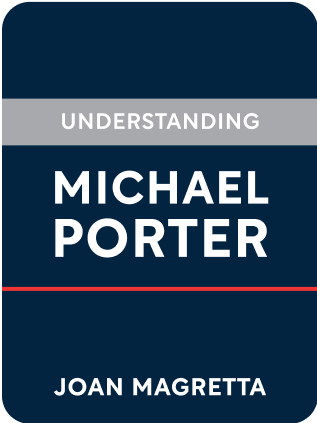

This article is an excerpt from the Shortform summary of "Understanding Michael Porter" by Joan Magretta. Shortform has the world's best summaries of books you should be reading.
Like this article? Sign up for a free trial here .
What is Michael Porter’s value chain analysis, and what does it mean for your business?
Michael Porter’s value chain analysis can help you understand how a company actually works based on the activities it performs in a specific sequence.
What is Michael Porter’s Value Chain Analysis?
Ultimately, a company’s strategy needs to be mapped onto what is actually done – the activities of a company. Activities are discrete economic functions or processes, like managing parts of a supply chain, operating a sales force, developing products, or delivering to the customer.
- Thinking about a company in terms of functions, like marketing or logistics, is too broad for strategy. Activities need to get granular.
The value chain is the sequence of activities that transform inputs into your products – including design, production, selling, delivery, and support. The value chain disaggregates a company into its strategically relevant activities to focus on the sources of competitive advantage.
- This provides a transformation on what a business does. See each activity not just as a cost, but a step that has to add some increment of value.
- Each activity may then be compared for the advantage it provides the company. Low-value high-cost activities might be discarded to better serve your target customer.
Your value chain is part of a larger value system, the set of activities involved in creating value from the end user (including activities that are outside your company, like in suppliers or distributors).
- Upstream, a car company buys tires from a tire specialist, and will need to think about whether to vertically integrate to produce its own tires.
- Downstream, a car company needs to think about how people can afford cars, and may support financing credit.
Ultimately, you bear responsibility to your customers for all steps of the value system. Customers don’t care if your suppliers are at fault, so you have to cover potential upstream and downstream problems.
- McDonald’s needs to ensure supply of potatoes, which requires seeing potato farmers as part of the value system.
Companies that have different strategies should have different value chains. If you have the same value chain as another competitor, you’re competing on price.
A typical value chain includes:
R&D -> Supply chain management -> Operations -> Marketing & sales -> Post-sales service
Value Chain Analysis
1. Lay out the industry value chain.
- How do the industry’s activities extend upstream or downstream?
- What activities create value at each step?
- Compare the value chains between rivals.
2. Compare your value chain to the industry’s value chain.
- If your value chain looks like everyone else’s, you’re competing to be the best. Your set of activities should be meaningfully different to have some kind of competitive advantage.
3. Focus on price drivers, activities that have a high impact on differentiation.
- Could you create superior value for buyers by performing activities in a distinctive way, or activities that competitors don’t perform?
- Can you create this value without increasing commensurate costs?
- Unpack: Are there differences in particular product lines, geographic areas?
4. Focus on cost drivers, activities that represent a large percentage of costs.
- Unpack: Get an accurate picture of the full costs of each activity, including direct operating, asset, and overhead costs.
- What specific overhead costs could be cut if you stopped performing this activity?
Examples of Value Chains
Magretta shows three possible value chains for the same goal – providing wheelchairs for developing areas. Consider three different types of organizations servicing this need:
- Refurbisher: Procures used wheelchairs from hospitals, refurbishes them, and ships them to recipients
- Volume purchaser: Fundraises and buys high volumes of basic wheelchairs from China
- Whirlwind: Designs proprietary higher-value chairs and works with regional producers to create them
Even though each organization nominally services the same problem, they each have distinct strategies, and activities to service those strategies. When plotted on a value chain, the differences are apparent:
| Chair design | Operations | Distribution | Provision/fitting | After-sales repairs | |
| Refurbisher | No | Collect used chairs and refurbish them | Ship from US | Send volunteers from US | No |
| Volume Purchaser | No | Outsource production of chairs at high volumes and low costs | Ship from Asian producer | No | No |
| Whirlwind | Yes | Partners produce designs | Regional producers ship to partners | Local partners provision and assmelbe | Yes |
Here are more differences in how companies can use value chains to drive strategy:
- Southwest might focus on gate turnarounds as a significant cost driver. One level deeper, it would unpack all the subactivities to turn around a plane. It might find then that draining the lavatories impedes the ground crew’s other activities. Southwest would then get its supplier Boeing to reposition the service panel on the new plane.
- Investment brokers had a fully integrated set of activities, including analyzing securities to executing trades. Charles Schwab created a different value chain – not all customers want advice, so why should they pay for it? Focus on executing trades and you create a different kind of value.
- By analyzing their value chain, automakers in the 1990s may have seen that scale wasn’t a compelling cost driver. Had they done this, they might have resisted getting large at the expense of profitability.
Michael Porter’s value chain analysis can help you determine a businesses value and profitability based on its activities. You can learn more about Michael Porter’s value chain analysis and apply that and the five forces model.

———End of Preview———
Like what you just read? Read the rest of the world's best summary of Joan Magretta's "Understanding Michael Porter" at Shortform .
Here's what you'll find in our full Understanding Michael Porter summary :
- How Porter's famous Five Forces help you analyze every industry
- How IKEA, Southwest Airlines, and Zara have ironclad, defensible strategies
- Why the best companies reject opportunities to focus on what they know






